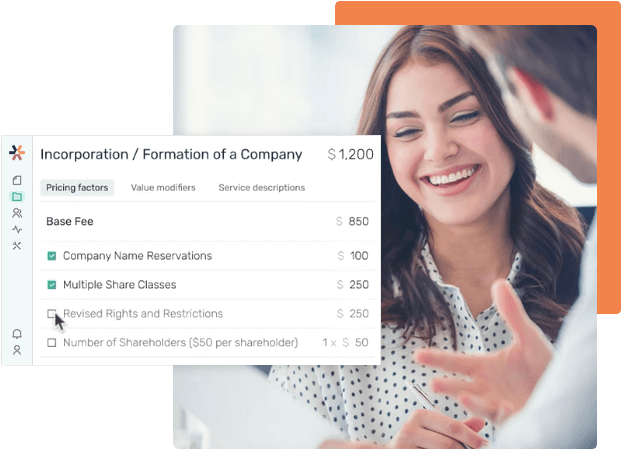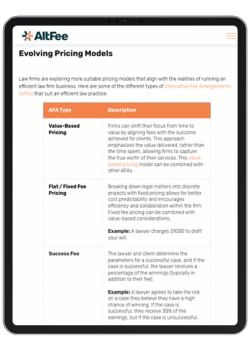- Resources
- A Guide on Contingency Fee as a Valued-Based Billing Option
Table of Contents
If you grew up in a certain era (aka the 90s) you might remember being woke up at 3 a.m. by an aggressively loud personal injury commercial, with a confident lawyer touting that they “don’t get paid unless we win”, often with fire or some other low-budget special effect sealing adorning the background.
This Youtube video has an excellent compilation of the best ones — with the second commercial being basically an exact demonstration of what we’re talking about.
Thankfully we don’t really see too many of those types of commercials anymore. But as cheesy as they were, the idea that a client doesn’t have to pay their lawyer unless the case's outcome is successful is an interesting one. This type of value-based pricing fee structure is called a contingency fee.
But it begs the obvious question: why would a lawyer take on a case where they aren’t guaranteed payment? Well, there are a few reasons. First, they are almost 100% sure that they’ll win the case, and secondly, they might even get paid more for winning the case than if they would’ve charged the client their typical fees. Third, giving your client more options for paying legal fees is one of the ways that a law firm can showcase its commitment to a client-centric approach, and improve attorney-client relations.
From the client’s perspective, they get access to justice without having to fork over the cash initially. If the lawyer does get paid more than would be typical, maybe that’s ok; after all, the lawyer is assuming all of the risks, and the client doesn’t have to worry about being able to pay.
But contingency fees are complex, with many rules surrounding when and how they can be applied to legal cases, as well as considerations as to when they would be good to use and when they wouldn’t.
This article explores the lawyer contingency fee from beginning to end, including what it is, the legal matters it's typically used in, and much more.
What is Contingency Fee for Attorneys
The contingency fee definition refers to an agreement between an attorney and their client that states if the case or matter is successful (the definition of success will also be determined at this time) then the attorney gets paid a percentage of the settlement. If it isn’t, then the attorney doesn’t get paid. In this case, the attorney is assuming all of the risks in the case because they believe that a successful outcome is likely.
A legal contingency fee can also mean a predetermined amount of money is paid to the law firm or lawyer in advance (typically a percentage) and the rest is contingent upon the success of the case (this is also commonly known as a success fee). This means that the risk is somewhat split between the client and the lawyer.
In short, a contingency fee is another flexible law firm pricing strategy that aims to benefit both the client and the lawyer.
Legal Matters Where Contingency Fee is an Option
When it comes to contingency fees and the types of legal matters they are typically used for, the following apply:
- Personal injury
- Medical malpractice
- Insurance claims
- Breach of contract
- Condemnation cases
Personal injury cases are arguably the most common types of cases where lawyers use contingency fees, but any of the above types of cases where a client feels that they experienced a wrongful result may be a good candidate for a contingency fee arrangement.
Experiencing an injury or denial of a claim because of someone else's negligence is a harrowing experience. But that negativity can be compounded when financial constraints make a client feel like they can’t get the justice they deserve. With a contingency fee, clients with legitimate cases that can’t afford typical attorney fees are given the opportunity to get that access to justice, while the attorney gets paid fairly at the same time.
Legal Matters Where Contingency Fees Cannot Be Used
There are some ethical considerations with contingency fees, such as what types of cases they can and cannot be used for. In the United States, lawyers are unable to use contingency fees for criminal cases, divorce and family law cases, and domestic relations cases, with similar rules in Canada.
- With criminal cases, there is usually no financial recovery, so using a contingency agreement to cover payment would be useless.
- Divorce and family law cases present ethical challenges with contingency fees because it ties financial interest to the case's outcome. For instance, in a divorce case, an ethical attorney should be focused on reconciliation, fairness, and resolution as the main goals of the case, which means that the best result may not be that divorce happens but rather that it doesn’t.
- Domestic relations cases present similar ethical challenges to divorce cases, specifically with tieing financial interest to the “successful” outcome of the case in terms of the client you’re representing. Since domestic relations cases are often closely tied or part of divorce cases, the same ethical principles apply: attorneys on both sides should be focused on fairness and resolution, and adding financial interest to that mix compromise that promise.
Types of Contingency Fee Systems
|
Type of Contingency Fee |
Definition |
Example |
|
Fixed percentage contingency fee |
The percentage that the attorney receives is the same throughout the entire proceeding |
A worker was injured, but their WCB claim was denied. The worker hired a paralegal to appeal. After appealing through the tribunal, the claim was approved. Because of the straightforward nature of the case, the paralegal received a service fee of 30%. |
|
Staged or Graduated contingency fee |
The percentage that the attorney receives changes depending on which stage the legal matter is resolved (e.g. resolved at settlement before trial, or after trial would change the fee accordingly) |
An unfair employment dismissal case was settled before trial. Because the attorney and client agreed that if the case didn’t have to go to court the contingency fee would be 20%, the lawyer took that 20% plus disbursement fees. |
|
Partial contingency fee |
The client pays for some legal services in addition to a contingency fee upon the successful outcome of the case |
A person who experienced medical malpractice wants to get compensation. However, their lawyer recognizes that the other side will want to fight the matter in court, and there’s a chance that the plaintiff won’t win. Therefore, the client agrees to pay the disbursement fees as well as give the lawyer a higher contingency percentage (40%) than normal because of the risk the case presents. |
How Should a Legal Contingency Fee Be Calculated?
Several factors go into determining how a lawyer would calculate a contingency fee for a case. For example, the percentage an attorney would charge for a personal injury case would include the following:
- The complexity of the case
- The experience level of the attorney or attorneys that are handling the case
- Nature and extent of injuries and damages involved
- Whether or not a lawsuit has been filed
- If the case is resolved via a settlement or at trial
Most contingency fee cases see lawyers taking an attorney contingency fee of between 33-40%, with the typical earnings for the lawyer being 33% (or one-third) of the settlement or award. It’s important to note that some provinces, such as BC, and some states in the US have caps on contingency fees, meaning you may be required to charge less than these proposed percentages.
You may want to consider charging up or down depending on the case, your region's rules surrounding contingency fees, and other factors.
To figure out the best way to set a contingency fee for attorneys, consider the following steps:
1. Ask colleagues and do research on attorneys in your area
The best way to answer just about any legal question you may have is to do your research. This means reaching out to those in your network who have charged an attorney contingency fee before, and looking up what other lawyers in your area charge for similar types of cases.
When it comes to collaborating on pricing strategies with your colleagues within your law firm, having the right software to facilitate that collaboration is paramount. AltFee makes it easy to create and manage pricing templates, called guidelines, and receive contextual feedback from internal stakeholders. For example, when a new guideline is created for a particular practice area, a colleague can contribute an insight that appears beside the relevant guideline within AltFee’s software; these insights are then attached to all future uses of that guideline as new matters are created providing initial context as users go to price out similar projects. Additionally, within a client matter, colleagues contributing to the pricing of a particular client project have the ability to leave notes, track the history of scope changes across the lifespan of a project as well as continue to add additional custom factors as required. Keeping all communications in one place and ensuring that the context behind feedback isn’t lost is key to a successful alternative pricing system.
Start Earning More Revenue with Fixed Fees
Break free from hourly pricing and take the fear out of scoping and pricing client projects to start maximizing profitability.
Book A Demo
2. Check state or provincial contingency fee law
There are serious ethical considerations regarding what types of cases are eligible for a contingency fee model, as well as how they can be charged. Typically, contingency fees can’t be used for family law cases. Still, in California, contingency fees can be applied if a client wants to recover monies related to unpaid child or spousal support, but only after a judgment in the case has been reached. Most states also have caps on the percentage that attorneys can charge with contingency fees, but some states, like Florida, don’t have caps. It’s important that you look up your state’s rules before setting a percentage.
3. Weigh all the factors involved in a case before setting a fee percentage
Rule 1.5 of the ABA suggests that lawyers take the following into account when setting any type of legal fee for each case:
- Time and labor required
- Skill, ability, and experience required to perform the legal service
- The typical fees that are charged by others for the legal service
- If accepting the case will prevent other employment opportunities for the lawyer
- Time limitations imposed by the client or the circumstances surrounding the case
- The nature and length of the professional relationship with the client
- Whether the fee for the service is fixed or contingent upon a result
Pros and Cons of a Contingency Fee
|
Pros |
Cons |
|
Potentially no upfront fees for the client, or a smaller upfront fee than would be typical for that type of matter |
From the client’s perspective, the case could end up costing them more than a lawyer’s typical fee if the case settles quickly (e.g. high-damage case that settle before a trial) |
|
Provides a greater incentive to the attorney for a successful case outcome; the attorney doesn’t get paid (or fully paid) unless the client gets paid |
The attorney assumes all or most of the financial risk |
|
From the client’s perspective, there’s no cost if the matter is unsuccessful |
There can potentially be a limit or cap on the financial compensation the lawyer (and client) can earn depending on the state (e.g. In Massachusetts, charitable orgs have a damage cap of $20,000, and most hospitals are registered as charitable orgs. This means that a medical malpractice suit could be capped at that amount — which may not be enough to cover lawyer fees, filing, discovery costs, etc.) |
|
May increase access to justice for clients with legitimate claims that could otherwise not afford to pay the expenses of the case |
From the client’s perspective, it may be more difficult to convince an attorney to take your case if the attorney doesn’t believe it will be successful |
|
Empowers a lawyer to take all action necessary to ensure the successful outcomes of the case, i.e. in some cases the client may not want to pay all the fees associated with the actions that a lawyer wants to take (subpoenas, depositions, etc.) but because payment is handled by the lawyer, they get to decide what actions to take |
From the client’s perspective, high disbursement fees may quickly eat into the earnings from the case, reducing the money they walk away with |
Q&A
What is a fair contingency fee?
A fair contingency fee for most lawyers is between 33-40% but may vary depending on the region, the case itself, and other factors, like the amount of risk. Certain states also have damage caps that limit the amount of payout that can be achieved for certain types of lawsuits, like medical malpractice lawsuits. California is capped at $250,000, while Connecticut, DC, and Delaware do not have caps for a medical malpractice contingency fee. It’s important to have a clear understanding of the laws surrounding contingency agreements and fees in your state or province before coming up with a percentage to charge your client.
Can you negotiate a contingency fee?
Yes, a lawyer contingency fee can be negotiated. In fact, the law promotes the negotiation of contingency fees based on the complexity of the case, the chance of winning, and more, with the actual agreement typically needing to state that the fee is negotiable between the lawyer and client.
Do contingency fees increase access to justice?
Access to justice has always been a concern in the legal industry. Those who require legal help but are unable to afford it are often left without recourse. A recent report from the LSC (which was held via live stream) states that as many as 92% of the civil legal problems faced by low-income Americans during the early years of the pandemic received either inadequate or no legal assistance. People that are disproportionately affected include seniors, veterans, children, survivors of domestic violence, those in rural areas, and those experiencing high housing costs.
In addition, civil legal problems among low-income Americans are often widespread, with 75% of the aforementioned households experiencing at least one significant legal problem in 2021, and up to 40% experiencing five or more.
While these statistics certainly illustrate an issue with access to affordable legal services, legal professionals are divided as to whether contingency fees are the answer. On one hand, some argue that while contingency fees increase access to a lawyer — especially for cases like personal injury — the amount of money that a client ends up paying from their winnings is still too high when compared to what it would’ve cost without the contingency agreement. On the other hand, contingency fees do give people with legitimate cases access to legal help when they otherwise would not have been able to afford it, so a little extra paid to the lawyer (which isn’t a guarantee, anyway) might be worth it.
In short, both the client and the lawyer have to weigh the pros and cons of using a contingency fee for the specific case at hand, and determine if it's the best option. It’s important that the lawyer is transparent about all costs involved, including disbursement fees, for instance, to ensure that the client is sufficiently educated to make the best decision for them.
When do contingency fees need to be court-approved?
In the United States, contingency fees do not need to be approved by the court in advance, but lawyers must abide by the Model Rules of Professional Conduct 1.5(c) as set out by the ABA. These rules are focused on transparency, meaning that the client must be fully aware and agree to all terms of the agreement, including any additional fees (such as disbursements) that they may be responsible for. Once the case has concluded, the lawyer is responsible for providing the client with a written statement highlighting the outcome of the matter.
The fairness of CFAs (Contingency Fee Agreements) in Canada, on the other hand, is highly regulated, with courts scrutinizing every case that it is used in to ensure it is fair and reasonable.
A CFA must be approved by a court when:
- Legal counsel is acting on behalf of someone with a disability, as per Sec. r 1.03 of the Rules of Civil Procedure for the definition of a “person under disability”, or if they are a minor.
- The agreement states that the counsel’s fees are to be based on a percentage of the damages and interest recovered plus costs paid by an opposing party.
- In a class proceeding (e.g. class action lawsuit).
What are disbursements in a contingency fee?
Disbursements are the expenses that the lawyer handling your case pays to third parties on your behalf. These expenses are things like court filing fees, medical assessments, mileage costs, money paid to experts, and more. The contingency agreement should state who is responsible for these costs if the case isn’t won.
Conclusion
Contingency fees are most often used for cases where compensation is sought because the client suffered in some way, such as personal injury cases, medical malpractice, insurance claims (where the claim is denied), and more. Contingency fees can be a lucrative way for a lawyer or law firm to earn business from a wider range of clientele and earn more money at the same time.
When calculating a lawyer contingency fee that is fair and reasonable, it’s important to take into account all the facts about the case, especially its complexity, chances of a successful outcome, and of course the resources that will be spent working on the case before determining a percentage to charge the client.
Offering the option of a contingency fee in your law firm for certain types of cases can be one way that you can showcase your commitment to a client-centric approach to legal services by offering alternative fee arrangements. While there are pros and cons to contingency fees, they do increase access to justice by offering clients another way to get the legal help they need, and at the same time provide a profitable outcome for the law firm on successful cases.
Whether you’re new to offering alternative fee arrangements or need a better way to manage your law firm’s AFAs, AltFee is the pricing and collaboration solution you need. The software allows you to manage your pricing while considering the input of everyone in your law firm.
If you’re ready to AltFee in action, start by getting a demo today!
Start Earning More Revenue with Fixed Fees
Break free from hourly pricing and take the fear out of scoping and pricing client projects to start maximizing profitability.
Book A Demo







Newsletter Signup
Subscribe to our newsletter to receive the latest news.



